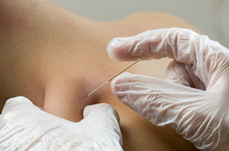
Myofascial Dry Needling is different to acupuncture.
Acupuncture is designed to relieve pain, discomfort, or issues by opening a person’s energy flow or chi. Myofascial Dry Needling focuses on stimulating trigger points or muscles that are tight and/or irritable.
Myofascial (or trigger-point) Dry Needling is an invasive procedure whereby a fine acupuncture needle is inserted into the skin and muscle. It targets myofascial trigger points – a small tight band within a larger muscle area.
Our therapists do not use MFDN in every session. It is one of many approaches that can be utilised, if needed.
When a tight trigger point is felt, sometimes there is pain referral from the pressure. If our therapists can feel a taut area and there is little-to-no pain, this may indicate a latent or old trigger point. This area of muscle is dysfunctional and is not contracting through its full range of motion.
The trigger point area has little blood flow, so cannot eliminate toxins within this taut area. This is also true for trigger points that, when pressed, refer pain either in the muscle itself, or to a nearby body part.
We use sterile, single-use acupuncture needles to deactivate and desensitise myofascial trigger points. This stimulates a healing response in the tissue and reduces the stress of the muscle. The needles are very thin, and you may (or may not) feel the needle enter your skin. If the target muscle is tight and supersensitive you may feel a cramping or twitch sensation. This is very short-lasting, and you soon learn to recognise this sensation as therapeutic as it is followed by a feeling of pain relief and muscle relaxation.
MFDN is a beneficial type of treatment to use on trigger points that are difficult to release and/or reoccurring.
Some patients experience temporary muscle soreness after the treatment. This may last for a day or two, and our therapists will advise how to minimise this. Other less common side effects include slight bruising. If you have any questions about side effects, please discuss this with our therapists.
Using MFDN on pregnant women in the first trimester is not advised. However, during the second and third trimester, MFDN can be used if needed and only on a limited number of areas. We screen each patient, and only use MFDN when safe.
Prior to treatment please inform our therapists if you are pregnant, or have any of the following:
- Are on blood thinner medication
- Axillary or inguinal node dissection
- Implants
- Joint replacements
- Metal allergies
- Needle phobia



